|
|
|
Sort Order |
|
|
|
Items / Page
|
|
|
|
|
|
|
| Srl | Item |
| 1 |
ID:
177753
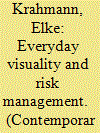

|
|
|
|
|
| Summary/Abstract |
Visuality is a central aspect of everyday security governance. In the recent visual turn in International Relations, however, the more mundane and routine visualities of security have been widely neglected. To address this gap, this article proposes a framework for analyzing the messages of security and risk conveyed by different modes of visual representations, ranging from press photos and educational images to outwardly appearances. Taking the United Nations Organization Stabilization Mission in the Democratic Republic of the Congo (MONUSCO) as an example, it shows that everyday visual representations reflect and contribute to security risk management in four ways: (1) They assist in the construction of self and other identities with regard to security, (2) they help to identify potential vulnerabilities, (3) they are used to educate people how to detect, assess, and behave in risky situations, and (4) they are employed to deter violent attacks.
|
|
|
|
|
|
|
|
|
|
|
|
|
|
|
|
| 2 |
ID:
185140
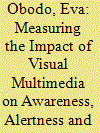

|
|
|
|
|
| Summary/Abstract |
The aim of this study was to determine the effectiveness of visual multimedia in promoting security awareness, alertness and behavioural intention towards kidnapping prevention measures among secondary school students. A quasi-experimental design was used for the study and the sample was made up of 470 secondary school students. It was found that respondents in the visual multimedia group did not significantly differ from their counterparts in the non-visual multimedia group on security awareness but they significantly differed on security alertness and behaviour intention towards kidnapping prevention measures. The implication is that visual multimedia has been highlighted.
|
|
|
|
|
|
|
|
|
|
|
|
|
|
|
|
| 3 |
ID:
184766
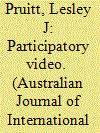

|
|
|
|
|
| Summary/Abstract |
This article considers the implications of incorporating participatory video in International Relations (IR) research. Drawing on existing aesthetic and visual IR research, I critically reflect on a case study incorporating participatory video in research investigating young women’s leadership in Asia and the Pacific. Through participatory video, young women redressed their common invisibility and challenged portrayals situating them as unable to lead and make decisions. In this way, participatory video disrupted and unsettled power relations often resulting in young people’s marginalisation from policymaking. Given its ability to make space for productive reflections on, and challenges to, existing power dynamics amongst and between researchers, research participants, and the state, participatory video can productively push the boundaries of IR research. Limitations and challenges of using participatory video are also evident and require reflection. Overall, I suggest that participatory video can generate new critiques and knowledge to productively shape current and future IR research, including through offering unique insights that could be missed by other methods in IR, including other filmmaking approaches.
|
|
|
|
|
|
|
|
|
|
|
|
|
|
|
|
| 4 |
ID:
171919
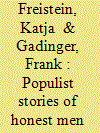

|
|
|
|
|
| Summary/Abstract |
This article proposes the methodological framework of visual narrative analysis through the study of images and narratives. We are interested in the appeal of political storytelling. In applying an approach of layered interpretation, we study images and slogans to consider the more complex underlying narratives in their political and cultural context. Our exploratory case studies draw on material from right-wing populist parties, namely election campaign posters from Germany and the UK as material for the analysis. We find that narratives operate with a ‘fantasmatic logic’, which adds fantasy to politics, to depoliticise and camouflage their radical intent and gain approval by making consent desirable. We identify two exemplary narratives (honest men under threat; proud mothers) that entrench traditional gender roles in accordance with patriarchy and nationalism. Theoretically, our approach contributes to debates in IR on cultural underpinnings in international politics and the construction of collective identities through shared/divided narratives. Visual narrative analysis provides a promising methodological tool for analysing visual representations in their productive relationship with text. This perspective foregrounds the power of political storytelling through fantasmatic appeal and fosters a better understanding of the global rise of populism.
|
|
|
|
|
|
|
|
|
|
|
|
|
|
|
|
| 5 |
ID:
174716
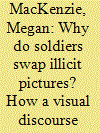

|
|
|
|
|
| Summary/Abstract |
Military service members have been taking and circulating illicit images for decades, and soldier-produced illicit images are a regular and coherent category of international images. Focusing on two case studies – Abu Ghraib images and images of hazing – the argument put forward in this article is that soldier-generated illicit images are not simply photographic evidence, or accidental by-products, of exceptional military activities; rather, these images – and the practices associated with these images – are central to, and reinforce aspects of, military band of brother culture. Soldier-produced illicit images establish a visual vernacular that normalizes particular practices within military communities. Moreover, the practices of producing, circulating and consuming these images convey explicit messages to service members about acceptable behaviour and norms around loyalty and secrecy. A method of visual discourse analysis is developed and employed to examine the acts captured in soldier-generated illicit images as well as the practices linked to the production, circulation and consumption of images. Building on existing work on military culture and images and international relations, this article makes a unique contribution by systematically analysing soldier-produced illicit images in order to gain insights about internal military culture and group dynamics.
|
|
|
|
|
|
|
|
|
|
|
|
|
|
|
|
|
|
|
|
|